With Voyager on my mind because of its recent anniversary, I had been exploring the Internet landscape for archival footage. But Ioannis Kokkinidis made my search unnecessary with the following essay, which links to abundant resources. The author of several Centauri Dreams posts including Agriculture on Other Worlds, Ioannis holds a Master of Science in Agricultural Engineering from the Department of Natural Resources Management and Agricultural Engineering of the Agricultural University of Athens. He went on to obtain a Mastère Spécialisé Systèmes d’informations localisées pour l’aménagement des territoires (SILAT) from AgroParisTech and AgroMontpellier and a PhD in Geospatial and Environmental Analysis from Virginia Tech. Now a resident of Fresno CA, Ioannis tells us in addition how a lifelong interest in space exploration was fed by the Voyager mission and its continuing data return.
by Ioannis Kokkinidis
Introduction

Back in the end of August 1989, when I was 9 ½ years old and the whole family was on vacation, the Greek press set aside momentarily its coverage of the continuing shenanigans of Greek politics and the rapidly changing situation to the north of our borders due to the collapse of communism and instead put Voyager 2’s encounter with Neptune in its front pages. My late grandfather was an avid reader of newspapers, which I would also read afterwards. I devoured what I could get my hands on, which alas was not much, it was after all August.
The next year my family moved to California for two years, my father was a visiting professor at UCSF, and I read all the books and magazines about space I could find in the public libraries. I even discovered NASA’s Spacelink, a NASA public education computer service hosted by the Marshall Space Flight Center in Alabama, containing mostly NASA press releases, and I would dial in with our PC XT’s 2400 bps modem. However feeding my space interest was a privilege and my parents made me do a thing I truly dreaded in exchange for dialing the long distance number and indulging myself: play the piano.
After we returned to Greece keeping myself appraised of the latest space developments proved difficult since there is very little popular scientific press in Greece and the mainstream press is not that interested in space. When I got our first internet connection NASA’s Spacelink, now a website, was still up, it still had similar content, though more importantly the releases now included in the bottom instructions on how to get on NASA’s press listserv. I promptly signed up, and I still am on that listerv, becoming informed of the latest space developments, especially in an era before the current proliferation of internet space media made it possible to get the latest space news whenever you wish.
Space in general and NASA in particular have been trailblazers in the formation of the current internet media landscape. Early internet users were for the most part technically savvy people with a strong interest in space. When Mars Pathfinder landed in 1997 it became the first major mass internet event with some 200 million hits on its website, at a time when the internet is believed to have had fewer than 500 million internet users worldwide. Space enthusiasts have always had interest that the mainstream media would not quite satisfy and NASA has indulged those interested, posting pictures, press releases and blogs online, up to the point that today the press conferences are open to all and NASA takes questions from the public in social media.
The ability to consume the latest information about space today runs the whole specter, from basic articles intended for children to conference and peer review papers for professionals, which amateurs can also try to parse for meaning. This was not the case though during the planetary phase of the Voyager program. Per the Voyager books and documentaries I have seen over the years the Jet Propulsion Laboratory held a series of daily press conferences during encounter times that apparently were taped, footage of them is shown in said documentaries. Being on the 40th anniversary of the launch of the most successful planetary missions, I wondered if any of that content was available online. I have discovered that quite a bit was, especially of the 1989 Neptune encounter. When I asked online I was also told, and I did discover, that JPL also produced on a daily basis, and at times more often, 10-15 minute Voyager update videos intended for a general public that were apparently broadcast on PBS, in addition to being shown at Planetariums and science centers. I was able to also find several of these videos are available online too. To my surprise very little of this content is uploaded from official NASA accounts, rather it has been uploaded and collected by enthusiasts.
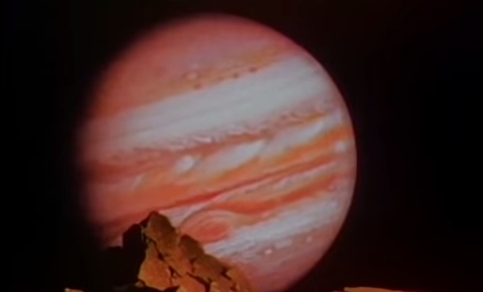
Image: Some documentaries mixed actual footage with artist’s renderings of the landscapes Voyager saw. This image is from a 1982 NASA presentation.
Understanding the origin of the content
NASA does have quite a bit of Voyager data and information up on its website. It still has the original press kits up, which I actually read them back when I dialed up at Spacelink. The scientific information collected is available for all at the Planetary Data System. Voyager has a website up, with a lot of retrospective information. There are several Von Karman lectures up on YouTube, as are press conferences organized both by NASA but also scientific societies such as the AGU. However these mostly date from the last 15 or so years, especially after YouTube was created. The older stuff has been put up by other people. Having watched the stuff and lived a few years both as a child and as an adult I have a few hunches on who is responsible for doing this public service. One needs first to understand how the education system works in the US.
In Greece primary and secondary education is highly centralized. The Ministry of Education in Athens decides what is to be taught in each grade, each class syllabus and even sends the school books and teachers to the public schools. In private schools the owners select their teachers, but the curriculum and books is the same as in public schools. For that matter the graduating exams at the end of the year there are given by public schools teachers to ensure that private schools are not places where bad students go to buy an education certificate. Students and parents have no control over what gets taught up to high school where some choice is introduced, except of course by their vote in the parliamentary elections, or even who teaches it, except by pressuring their local Members of Parliament. Physics teachers – who in Greece are all physicists graduates of four year universities – have no reason to entice students to take their class, the students are obligated to do so. Greeks schools are also seriously lacking in means, before an EU program about a decade ago only about 150 schools out of the 20,000+ that then existed in Greece had a school library, and though with EU funding and school mergers due to the financial crisis some 10-20% of schools now have a library, that is still a small fraction.
The American educational system is far more decentralized but also has more means. The federal Department of Education can set some guidelines and offer grants, but the educational standards are set at the state level. Major decisions such as hiring and school book choices are made at the school district level, with the school district being made up of representatives directly elected locally, rather than ministry of education centrally appointed functionaries. Now down at the school level students have quite a bit of class choice. As a result science teachers need to make their classes appealing to students in order to have them select it. One way to do so is to teach about cool things in class, and space is generally considered very cool. As a result teachers and schools have maintained such cool content like NASA produced educational material. Also American schools have many means not available to Greek schools, such as school libraries that can include a media section with such material. On top of that some 10% or so of American students are home schooled by their parents, and they often use such material to teach science class. Materials on the internet get copied around incessantly so it hard to track who is the original uploader, but after watching quite a bit of the material shown below I am under the impression that most of the videos have been originally taped by some science teacher or librarian, who eventually uploaded them online.
Jupiter encounters
Voyagers 1 and 2 encountered Jupiter back in 1979. Sony’s Betamax was released in 1974, VHS was released in 1977, there are testimonials on the internet of people watching the Voyager Jupiter updates as children every night on TV but if people recorded the updates at the time, they have not put them up, and neither has NASA. What I have been able to find is the following 24 minute video dating from 1982 that talks about the Voyager 1 and 2 encounters at both Jupiter and Saturn. The first 14 minutes are about Jupiter, the rest is about Saturn.
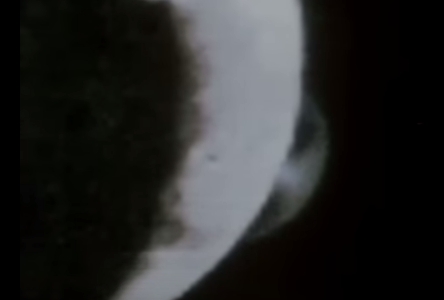
Image: Io’s volcanoes discussed in this 1982 broadcast.
https://www.youtube.com/watch?v=XAFXQ_EeyGs
Saturn encounters
Voyager 1 encountered Saturn in November 1980 and Voyager 2 in August 1981. We do not have online any of the daily press conferences or full Voyager updates; we do have though two educational documentaries from the time that include extended footage from them. In both cases they are of Voyager 2’s encounter with Saturn. Why Voyager 1’s encounter is not shown is unknown to me, but my guess is that these videos where shown in the run up to the 1986 Voyager 2 encounter with Uranus, and thus the idea was to show what Voyager 2 did in its last encounter. Both videos come from collectors of archival documentary footage on YouTube.
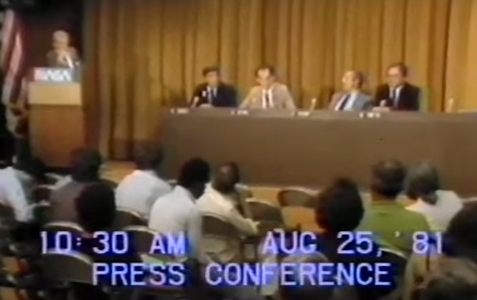
NASA Voyager 2 Spacecraft: Encounter with Saturn – 1981 Educational Documentary
https://www.youtube.com/watch?v=OGZk1SOIQaI
Voyager 2 Saturn Encounter as it Happened 1981 NASA Jet Propulsion Laboratory
https://www.youtube.com/watch?v=CJC4s5kijyU
Uranus Encounter
By 1986 video tapes had become more popular. While we do not have footage of any of the press conferences, we have footage of Voyager updates. This video begins in mid update, and then gives several other updates. It seems to have been recorded by somebody in Arizona, since interspaced among the Voyager Updates a small documentary about the USGS Astrogeology center in Flagstaff which is referred to as a local facility. Notice also the scroll for an upcoming Doctor Who episode.
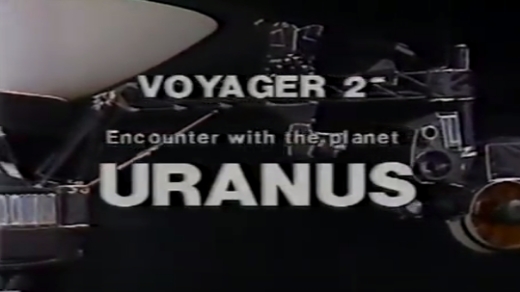
The Voyager Updates do not only deal with the Voyager program, they also give some more general NASA news. One of the updates give a retrospective on how 1977 when the Voyagers were launched Jimmy Carter was just sworn President and the Shah was still ruling Iran. Another updates talks about the upcoming 1986 launches of the Shuttle that will see Galileo, Ulysses and the Hubble Space Telescope get launched. Tragically, Challenger happened two days after Uranus closest approach.
https://www.youtube.com/watch?v=lnijUsIdxSc
Another interesting contemporary program from the time to watch is the Uranus episode of the long running BBC astronomy program The Sky At Night. The BBC has digitized its archive, though the link that YouTube gave me is not from a BBC account:
https://www.youtube.com/watch?v=hUriyE4sGd4
Neptune encounter
The Neptune encounter is far better documented than any of the previous five flybys. Its August timing, which meant that there was very little competing for attention, the experience over the excitement of the previous encounters and the ubiquity of video tapes means that there is quite a bit of material available. The first video is a preview press conference made three months before closest approach, with Ed Stone mostly recapping the previous flybys and explaining to the press new findings since published. In the end he also shows early Neptune pictures taken at the time:
https://www.youtube.com/watch?v=I4io958_BBo
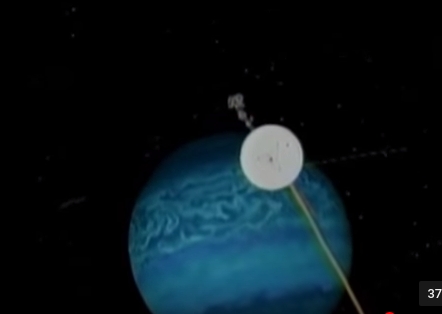 Image: Imagery shown by Ed Stone at the 1989 press conference on Voyager’s encounter with Neptune. Stone used these to explain what would happen in the upcoming encounter.
Image: Imagery shown by Ed Stone at the 1989 press conference on Voyager’s encounter with Neptune. Stone used these to explain what would happen in the upcoming encounter.
The following two videos, which appeared as YouTube suggestions after I had seen the rest of the material, purport to contain all the Voyager Updates of the Neptune encounter. They are over twelve hours, so I have only given them a cursory look:
https://www.youtube.com/watch?v=xkUmzPbqJVU
https://www.youtube.com/watch?v=CttozUMkEBA
CSPAN is the American equivalent of Parliament TV. Like Parliament TV it carries educational programs when Congress in not in session. Their oldest video tagged “Space” was a hearing on the Challenger disaster. They do not have Voyage briefings at Jupiter, Saturn or Uranus but they did show most of the Neptune press briefings. They also had an audience Q&A with the director of NASA’s planetary division, William Quaide on August 24, a few hours before Neptune closest approach. Interestingly most of the press conferences are not all the way to the end, CSPAN apparently cut coverage when they went over their allotted time.
August 21 1989 Voyager 2 Update
https://www.c-span.org/video/?8803-1/voyager-2-update
August 22 1989 Voyager 2 Update
https://www.c-span.org/video/?8812-1/voyager-2
August 23 1989 Voyager 2 Update
https://www.c-span.org/video/?8817-1/voyager-2-update
August 24 1989 Voyager 2 Update
https://www.c-span.org/video/?8855-1/voyager-2-update
CSPAN August 24 viewer call in with NASA chief scientist William Quaide on Voyager 2 at Neptune
https://www.c-span.org/video/?8857-1/voyager-ii-neptune
August 25 1989 Voyager 2 Update
https://www.c-span.org/video/?8864-1/voyager-2-flyby-neptune
On the evening of August 24 to August 25 PBS showed a program called “Neptune all Night” where they showed the hourly Voyager updates live and filled the time in between by having a panel in Philadelphia made of the host, a sci fi writer and a NASA scientist. They also had several guests, such as legendary Hollywood sci fi movie producer and several space scientists such as Jill Tarter. On top of that they did take several questions that were dialed in from all over the US. We do not see any of the panelists or guests, between the updates we have the panelists talking while television is showing Voyager animations such as flyovers of satellites or even Space Shuttle astronauts doing things in space. Two people did tape the program beginning at different points. The first video is from a Florida station and it is of middling quality. It is over five hours:
https://www.youtube.com/watch?v=VBR5OUtndg8
The second video is from New York’s PBS 13 and contains far more ads to become a subscriber to PBS than the previous video, or the Arizona PBS Uranus video. The tape is of higher quality, but in begins at the equivalent of the 4h 34 minutes mark from the previous video.
https://www.youtube.com/watch?v=G84w-z6LkDo
The two hour tape ended before the program did, a little after the 3 am Voyager Update. However NASA solar system exploration has put up the last three Voyager Updates of the morning of August 25, for 5 am, 6 am and 7 am in a YouTube video entitled “Voyager 2 at Neptune with Suzy Dodd”. Suzanne Dodd is the current Voyager project manager and she does host the 5 am and 6 am update, though not the 7 am update. At 8 am there was no update, instead Vice President Dan Quayle gave a speech that CSPAN has at its archives in two parts. The Suzy Dodd video is in much better image quality that the rest of the Voyager videos, either at YouTube or CSPAN. Very likely NASA still has the original videos in its archives and at much higher quality than what I found online.
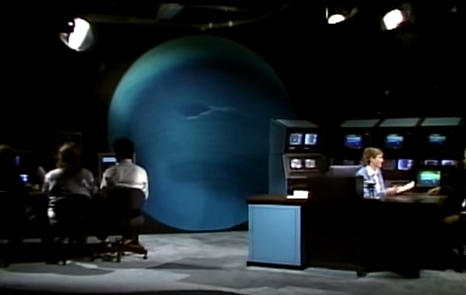
https://www.youtube.com/watch?v=AR_R5mFk9Tc
The Neptune encounter was big enough news that several mainstream media organizations made special reports about it. These YouTube videos do not come from the official station accounts. The first is a CNN special report on the Neptune encounter.
https://www.youtube.com/watch?v=Y11CVuxfvPE
The second special was made by TBS and contains reporting from Japan, which did participate in the Neptune and Triton Voyager occultation. It is hosted by Sidney Poitier and is available in 8 parts. The 8th part contains Chuck Berry playing live three songs at the Planetary Society’s farewell party.
Part 1 of 8
https://www.youtube.com/watch?v=y038-R3kwfw
Part 2 of 8
https://www.youtube.com/watch?v=gKVnzfiw1ac
Part 3 of 8
https://www.youtube.com/watch?v=c8eqYVFgzIU&t=5s
Part 4 of 8
https://www.youtube.com/watch?v=KPVwM7ikI4E
Part 5 of 8
https://www.youtube.com/watch?v=k7e1NDj-v0o
Part 6 of 8
https://www.youtube.com/watch?v=oKfVo_r4q7M
Part 7 of 8
https://www.youtube.com/watch?v=w8Uw1_Rad6Y
Part 8 of 8
https://www.youtube.com/watch?v=2adIOstO51g
Finally Sir Patrick Moore, who most likely was not knighted yet at the time, hosted a Neptune encounter episode for The Sky At Night. This program is far more complete and interesting, in my opinion, than the two other specials.
https://www.youtube.com/watch?v=H9UdqHL6b9Y
The Pale Blue Dot Press Conference
On June 6 1990 Ed Stone and Carl Sagan gave a press conference that for the most part summarized what the Voyagers had found during their planetary mission and revealed to the world the family portrait of the Solar System that Voyager 1 took. It was in this press conference that the famed Pale Blue Dot single pixel image of Earth was revealed. For the first 40 or so minutes Ed Stone gives a retrospective of Voyager, repeating for the most part what he had said a year earlier in the three months before Neptune press conference. He also though gives a few scientific updates on Neptune. After 40 minutes he shows the family portrait of the 6 planets, followed by Carl Sagan talking for 10 minutes on the portrait, followed by 30 minutes of Q&A.
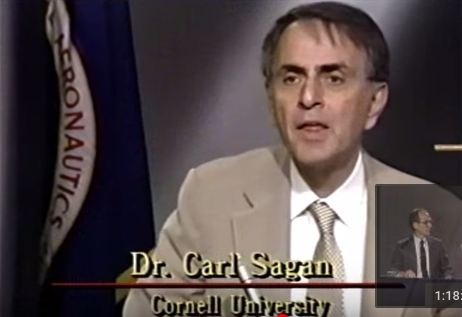
https://www.youtube.com/watch?v=ZQCTgCF8Khk
The videos in retrospective
Over a quarter of a century since the Pale Blue Dot press conference the more interesting part about these videos is what they reveal about the time they were produced. In the Neptune press conferences the Voyager team fielded questions from West German reporters, the Wall after all fell in October 1989 and Germany was reunified in 1990. Carl Sagan proposes that we have a Joint US Soviet program to send people to Mars, the collapse of the Soviet Union was completely unexpected for everyone. Viewers tend to ask the same questions: Why is Voyager 2 not going to Pluto? Why did Voyager 1 not also visit Uranus and Neptune? Why did you choose Triton over Pluto? Did you find any evidence of alien life, preferably intelligent? When are we sending people to Mars? Did you find evidence of a wormhole, like in Star Trek The Motion Picture? Can you talk about the Golden Record?
The Voyager team does promote the next steps: We will use Hubble Space Telescope images, after its upcoming launch, to follow up on Uranus and Neptune. Galileo to Jupiter is about to launch, and we have proposed Cassini and CRAF as follow up, if Congress approves the missions. Magellan was launched 6 months ago, the long launch gap is over, and it was due to the Challenger disaster. With the power of hindsight we can follow up. Magellan has been called Voyager 3 because it followed its engineering. It was very successful but it is alas the most recent American mission to Venus. Galileo was also a successful mission but suffered from being unable to unfurl its High Gain Antenna. Cassini was approved, and its mission just ended. CRAF though, which intended to flyby an asteroid and orbit a comet on which it would throw a projectile was cancelled. Its science goals though were investigated by Stardust, Deep Impact and Rosetta.
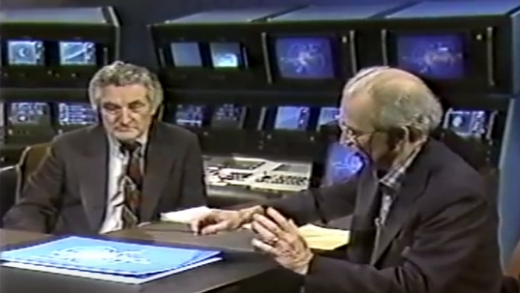
Voyager afterwards
The Voyager program did not end with the Solar System family portrait, for that matter it was not even the last images taken by the imaging subsystem. At the time both Voyagers were used as astronomical observatories, targeting stellar sources in the Ultraviolet. A few months later though they rewrote the spacecraft’s operating system and turned off all the instruments except those measuring fields and particles. During the Shoemaker Levy 9 collision NASA considered reactivating the imaging system to take pictures of the event which was not visible from earth. By that time though the imaging team had dispersed and it was hard to reassemble it. In any case Galileo, en route to Jupiter, took better images. From the Jupiter video already it was repeatedly stated that their last target was the edge of the heliosphere. In the Jupiter video Ed Stones expects that to happen by the end of the century, in the Pale Blue Dot conference he expected that in the first decade of the 21st century.
Throughout the 1990s I would read on any updates on the Voyagers sent by the NASA listserv. Most often they were associated with launch anniversaries or lectures at the fall AGU meeting in San Francisco. Both spacecraft did keep on moving outwards into unexplored part of the heliosphere. Voyager 1 crossed the termination shock at 94 AU in December 2004 and Voyager 2 crossed it at 84 AU in August 2007, entering the heliosheath, where the solar wind is subsonic. Where it ended and the Galactic magnetic field started was a point of contention, especially since the plasma spectrometer on Voyager 1, though not Voyager 2, has failed. In 2012 Voyager 1 did see a dramatic increase in external galactic cosmic rays as opposed solar particles, but we were not certain if the spacecraft had crossed into interstellar space because the magnetic field had not changed direction. Eventually though tape playback of the plasma wave instrument data showed that indeed, in 2012, Voyager 1 had crossed the heliopause and was now in the Galactic magnetic field. Voyager 2 has yet to cross the heliopause though that is expected to happen relatively soon.
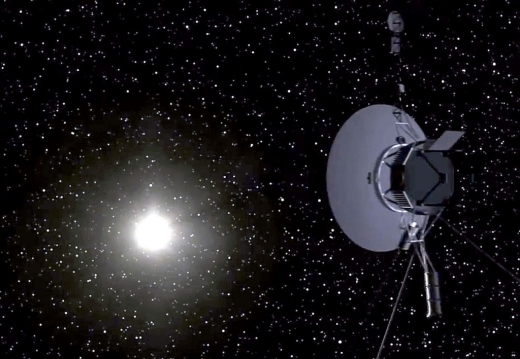
Image: Voyager moving beyond the Solar System. Credit: NASA.
The Golden Record
It seems that no Voyager article or documentary is complete with talking about the Golden Record and so will I. In all honesty I always found the pictures taken by the Voyagers more interesting than the record. The artifact is intended to be read by aliens who might run into the probes and contains instructions on how to use it. The instructions assume that the aliens are capable of interpreting the visual signs that we have put up sufficiently to decode the contents of the record. This is a very large assumption considering we have no idea what aliens can do and how. For one thing over a century after their discovery, Linear A tablets have never been deciphered. We believe that like Linear B tablets, which are written in Greek, they are accounting ledgers from the Minoan palaces where they were found, but until we read them we cannot be sure. On top of that the Voyager symbols are written in unique characters. The Phaistos Disc is written in a unique script, closest relative of which is the Arkalohori Axe. Wikipedia lists 26 decipherment claims for the Phaistos Disc which remain fanciful since we cannot apply them to another text to see if they make sense there. Michael Ventris’ decipherment of Linear B became accepted after it was used to read tablets that were published after he and John Chadwick published his discovery. Perhaps it would have been better if we had also printed instructions in English.
But say that alien do read the record, which contains both images and sounds coded differently. On top of that the human speech is in 55 languages. Much as Sagan and Druyan did try to give a snapshot of all human civilization, it is very hard to claim that it is an objective view of mankind. None of the contents, either images or songs, deal with war or any other ugly part of humanity. Trying to understand human civilization from the Golden record is like trying to understand Athens of the Classical Era from Pericles’ Funeral Oration: Both are wonderful documents but they portray their world as they wish it to be, rather than what it is. Still though they tell us quite a bit about ourselves and it was a great idea to include the Golden Record on the spacecraft. I sincerely hope that the project to write a repository of Earth Information on New Horizons does happen.



The new documentary on the Voyager missions recently shown on PBS Television, The Farthest, contains clips from a number of press conferences throughout the probes’ voyages to those outer worlds:
http://www.pbs.org/the-farthest/home/
One clip from it I had not seen before was the press conference given by the Voyager Interstellar Record team just days after the launch of Voyager 2 in 1977, hosted by Carl Sagan of course. If anyone knows where that video in full is available, or even a transcript, I will be eternally grateful. Why this has not been made widely available four decades after the fact is a cultural crime.
Now speaking of the Voyager Interstellar Records as you have, I note that you say you like the images taken by the probes over the record itself. Well that is of course your choice, but why can’t you like both? Why does modern society have to compartmentalize everything and then declare that one thing is better than another?
Both serve their purposes: Yes of course the Record would never have happened if the probes had not been built and launched into deep space and no one at time would have produced an entire space mission around just sending a message and information about humanity and Earth into the void for some unknown alien recipients. But once the main science mission is done – and officially it ended after Neptune in 1989, everything else since then has been a bonus – the Voyagers have what might as well be all eternity to drift throughout interstellar space.
Now they will serve as our representatives, not only for any potential ETI but any descendants of humanity who would very likely appreciate an artifact from the earliest days of the Space Age. Having those records attached to them containing images, sounds, languages, and music from the late 20th Century is nothing less than a cultural treasure beyond price for our future children.
Just ask any historian or archaeologist what they would give for such a literal record from a past civilization. Then ask any scientist across multiple disciplines what they would give for something similar from an alien race.
One other thing that some people do not quite seem to get about the making of the Voyager Records: The team had only six weeks to put it all together. In a world where the Internet was largely still a plaything of the military, universities, and a few corporations. Where as you note, VCRs were but fancy and expensive devices owned by a relative few. My best friend had a VCR in 1978: It cost one thousand dollars in contemporary money and was the size of a large suitcase.
That they put it all together – while keeping in mind that certain folks at NASA did not want the Golden Records to happen at all for various reasons – and got it onboard the probes in time has to be some kind of small miracle. For the full story, please find yourself a copy of the 1978 book Murmurs of Earth, written by the entire Voyager Record team and published by Random House.
Believe me, one day when the science of the Voyagers are surpassed by future missions, and we have already seen this with Cassini at Saturn, the Records will still live on, serving a far grander purpose that may benefit us and multiple species in ways we can only imagine.
Here is my further take on these matters when I wrote about another similar project called The Last Pictures, which was an artist’s response to the Voyager Records:
https://centauri-dreams.org/?p=26171
All this being said, I am most grateful to you for making the effort to scour the Internet for these records of the Voyager missions. It is only sad that they are not better preserved and made more widely available considering their historic and scientific value. It is also sad that an era I remember so well feels so technologically backwards in certain respects, all in the face of two robots being sent billions of miles across first interplanetary and interstellar space to explore strange new worlds.
Then again, we landed astronauts on the Moon using computers developed specially by MIT with 1600 bits of memory. One of the many dualities of the human species – which is also represented by having the Golden Records on the two Voyagers, instruments of both our minds and souls together.
To be honest try not to read my critique as a take down of the effort made in creating the Golden Record in the short time taken. I am saying that I would have made different choices: I think that along with the happy and smiling people they put on the record, they should have also put things like say one of the haunting images from the liberation of the Mauthausen concentration camp. The Golden Record in the end is a record that talks a lot about its time and how the earth is and we would like it to be. Pericles’ Funeral Oration (to use my analogy) is a text which has been called The Gospel of Democracy and it is one of those required fundamental text in understanding the ideal of democracy and the democratic process. However if you are to read the rest of Thucydides on how Democratic Athens actually work, the critiques of Democracy in Plato and Aristotle, who both consider it a deviation from the ideal regime, Plutarch’s biographies on how prominent statesmen manipulated it for their gain, already from the beginning, Aristophanes’ comedies giving us glimpses of how the poor actually saw it or Xenophon who hated it because it killed his teacher Socrates, you get a far more spherical view. Could the team have done a different job? Sure, but then again what was the aim of the project? From the content you see a very real and very decent attempt to give an optimistic snapshot rather than a realistic snapshot of the Earth and its culture. This in turn reveals a lot about its era and its makers. Pericles (if of course Thucydides does not put his own ideas in Pericles’ mouth) did not set out to give an objective view of Athens at its peak, rather to tell the relatives of the Athenian dead of the first year of the Peloponnesean War why their sacrifice was worth it, and along the process gives us a snapshot of how Athens at its peak strived to function. Like all artistic compositions in the end it is a product of its creators and reveals quite a bit about them.
Now what I am saying is that I always found the pictures more interesting than the record. I am pretty sure that they will be surpassed and we already saw it with Cassini. However in the end you do not read the geographic descriptions of Herodotus to get an accurate geography of Earth. After all Herodotus believed that the Earth was flat, the chariot of the sun rose every day somewhere over India which was hotter during the morning than the rest of the day since it was during morning that the sun was over it, and he was not certain if the North Sea existed since he had heard the rumors but he had never met a captain that had sailed on it. We read Herodotus for his description of the battles and of the peoples at the time that he wrote. Also since his time the geography has changed, for example lake Tritonis has dried out. But this is in the end an issue of personal taste.
I am hoping that people share here or elsewhere any finding they have of conferences or Voyager updates. All contributions are welcome.
If you can get ahold of a copy of the book Murmurs of Earth as I mentioned in my comment above, you can read about how the Voyager Record team did not want anything that might be considered negative if at all possible.
The idea was that the records were among the first introductions of our species to the rest of the galaxy, and usually initial meetings between strangers involve at least one party putting their best face forward. So that is what the Voyager Record team wanted to do here. If nothing else it will show any ETI an aspect of our thinking and culture.
For example, they did not want to show a nuclear weapon being detonated, as it could be interpreted as a threat, despite the possibility that a nuclear bomb could seem rather feeble to an ETI that can move between star systems.
If you check out Trevor Paglen’s 2012 response to the Voyager Records via his The Last Pictures art project, which I also mention above and link to an article I wrote on it for this blog, you will see that Paglen deliberately included many less than savory aspects of humanity among the 100 images he had etched into a wafer disc and attached to the geostationary comsat EchoStar 16. This included a nuclear bomb test and a family affected by Agent Orange.
So when the ETI find one of the Voyagers drifting in the void and are dissatisfied with the incomplete picture Sagan et al provided on that Golden Record, they can then fly to Earth at find the EchoStar 16 Artifact, as it is called, to get the whole story of the creatures from Sol 3.
Quoting Ioannis Kokkinidis from the main article:
“Magellan has been called Voyager 3 because it followed its engineering. It was very successful but it is alas the most recent American mission to Venus.”
The main bus of Magellan came from a spare bus for the Voyager probes. The large white high-gain antenna that helped to radar map the surface of Venus like never before was also a Voyager spare.
A medium-gain antenna carried by Magellan was originally a spare for the Mariner 9 probe that became the first spacecraft to orbit Mars back in 1971.
Seeing as Voyager 1 and 2 were originally going to be called Mariner 11 and 12, it is safe to say that Magellan is also a more-or-less direct descendant of the legendary and pioneering Mariner family of space probes. Or at least a close cousin.
I didn’t know the details, thanks for letting us know
You are welcome. I am just glad these parts were used on an actual space mission, rather than left on a shelf or as some museum display collecting only terrestrial dust.
The Miranda shots of the racetrack and chevron made me gasp–I thought this was evidence of ET–it looked strip-mined.
What would a deliberately mined moon or planetoid look like….
We have certainly learned a great deal of knowledge of planetology and planetary science from the NASA voyager spacecraft especially about the outer solar system and gas giants. The pioneer missions were first to Jupiter and Saturn, but the voyager spacecraft had the higher resolution cameras and photos and superior remote sensing instrument package. The Jupiter and Saturn encounters were awesome. I wondered if life was on Titan after the Pioneer 11 encounter. The radio occultation signal used to tell atmospheric pressure of Titan was garbled as Pioneer 11 passed behind it in 1979 so no one knew the exact pressure on the surface of Titan until the voyager one encounter in 1980 which was spectacular like the Neptune encounter.
The Voyager spacecraft was also used in first Star Trek Movie, one of my favorites.
That was Voyager 6, which by the time NASA-JPL got around to launching they couldn’t be bothered with another record or even a decent plaque, just a nameplate with a few items borrowed from the Pioneer Plaque and Voyager Record.
http://memory-alpha.wikia.com/wiki/Voyager_6
Apparently the highly advanced Artilect ETI which found and upgraded Voyager 6 could not wipe some space schmutz off the nameplate, thus the whole V’Ger name thing.
And they never said what happened with Voyager 3, 4, and 5. Though we do know the sad fate of Pioneer 10 in the subpar 1989 film Star Trek 5….
http://www.dailymotion.com/video/x4joe21
I found the whole thing with Titan very frustrating. It was rather obvious even from the Pioneer 11 images in 1979 that the moon was completely cloud-covered. They had hoped to catch glimpses of the surface through some alleged breaks in the cloud deck with Voyager 1, but that was proven a fallacy when the probe flew by in 1980. Going to Titan kept Voyager 1 from exploring any other worlds, including Pluto in 1986.
http://www.drewexmachina.com/2015/11/12/voyager-1-the-first-close-encounter-with-titan/
The real kicker is when Cassini showed up in 2004 and sent back the first surface images of Titan. The scientists were initially confused by what they saw even when the radar images were clear. So this just shows that had Voyager 1 even been able to see glimpses of the moon’s face, it would have left far more questions than answers.
They should have saved a future probe dedicated to Titan to get the real answers they wanted. The Voyagers were too precious to waste on any one world.
Jim Bell did address the Titan vs Pluto for Voyager 1 question in his book “Voyager : The Interstellar Age”. He says that everyone chose Titan over Pluto in the Voyager team at the time, it was not even a question. Also, we must not forget that at the time people were not sure if the spacecraft could survive the long trip, which sounds quaint today but was a real concern at the time
This catalog has a wide selection of Voyager-related coverage. I haven’t tried to secure any of it, though. I’d love to see the Jupiter – Uranus material. There even seems to be a lot of raw footage of the people of the mission at work. This would be extremely interesting material to compile in chronological order along with the image sequences taken by the Voyager cameras, like the stuff Spacecraft Films released a while back.
https://www.jpl.nasa.gov/videos/vidcat.pdf
Interesting list, which I am sure it will prove useful for anyone doing a project and has the time to request video (I did my search mostly for fun). It would be nice if they had that material online, though I am sure that some intern will do so eventually.
Quote by Ljk “The real kicker is when Cassini showed up in 2004 and sent back the first surface images of Titan. The scientists were initially confused by what they saw even when the radar images were clear. So this just shows that had Voyager 1 even been able to see glimpses of the moon’s face, it would have left far more questions than answers.
They should have saved a future probe dedicated to Titan to get the real answers they wanted. The Voyagers were too precious to waste on any one world.” I can’t agree with this. Planetologists are not limited to just the images they see. They also use Cassini’s remote sensing instruments infrared, ultraviolet spectrometers etc. Cassini’s infrared spectrometers proves the lakes on Titan’s surface are made of liquid methane reveal the chemical composition of surface features, frozen liquids etc. https://en.wikipedia.org/wiki/Lakes_of_Titan https://www.nasa.gov/feature/jpl/cassini-explores-a-methane-sea-on-titan
It’s infrared spectrometer allowed Voyager one to detect methane in Titans atmosphere and it’s the low surface temperature which lead planetologists to speculate that the Titan’s surface might have lakes of liquid methane, a prediction which came true. The temperature on the surface of Titan is close to the triple point of methane so it can exists as a liquid, gas, or frozen. Gerard Cooper detected spectral bands of methane in Titans atmosphere in 1944 through a telescope with a spectrometer.
The near infrared, mid infrared, far infrared are invisible to the human eye. One needs night vision glasses and infrared cameras. CH4 also absorbs light in the infrared and can be detected by an infrared spectrometer.
The BBC’s “Horizon” science programme ran two special episodes on Voyager, “From Earth to Miranda” and “Encounter with Neptune” – I remember a large part of my school being herded into a lecture theatre to watch them. Thrilling stuff.
A Google Search shows the programs available online. I found From Earth to Miranda here:
https://ok.ru/video/281899633381
I have not looked at it and I have no idea if the website is safe. Encounter with Neptune leads to another link:
https://ok.ru/video/281899698917
But Google also gives more stuff. BBC Horizon encounter with Jupiter 1980:
https://vimeo.com/227875464
and here:
http://www.dailymotion.com/video/x3qahp2
I don’t know if it is the same content. Going down the same rabbit hole, BBC Horizon s1981e14 15 Resolution on Saturn
https://www.youtube.com/watch?v=P3ZMCKkrrOw
BBC Horizon s1986e19 Uranus Encounter
https://www.youtube.com/watch?v=iEYJRNy78R8
For some reason the Jupiter and Saturn videos are about the Voyager 2, flyby, at least per their description. Wasn’t Voyager 1 important? Never though of BBC Horizon, for the simple reason that it did not pop up in my search results, thanks
Making The Farthest journey: An interview with director Emer Reynolds
by Emily Carney
Monday, October 23, 2017
“Now, voyager, sail thou forth, to seek and find.” – Walt Whitman, “The Untold Want”
If the Voyager program had been a fictional movie, it would have been unbelievable to audiences. The program, which celebrated its 40th anniversary in August, has possessed its fair share of drama, traumas, and jaw-dropping moments in which scientists on Earth were able to gaze upon strange new worlds for the very first time.
Full article here:
http://www.thespacereview.com/article/3353/1
To quote:
Plus this wondrous tale of the spacecraft and its curious and precious cargo, the Golden Record, was one that amazingly had never been told on a cinema screen before. There had been fine TV documentaries made, but it had never been given the full epic cinema treatment that this glorious and thrilling story deserves. It has the classic elements of all great stories: compelling, emotional characters; adventure, ambition, and danger; dazzling science and unimaginably exotic locations; love, music, and politics; time travel, controversy, exploding stars, colliding galaxies…and aliens! This is a film for anyone who has ever looked up and wondered.
The Farthest is being shown again on PBS Television on November 15:
https://arstechnica.com/science/2017/11/set-an-alert-do-not-miss-the-farthest-on-pbs/